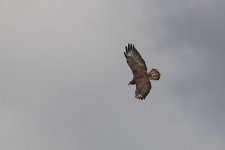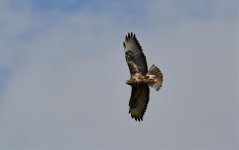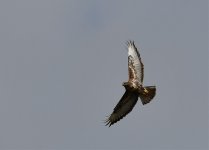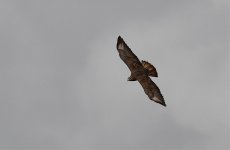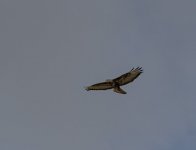-
Welcome to BirdForum, the internet's largest birding community with thousands of members from all over the world. The forums are dedicated to wild birds, birding, binoculars and equipment and all that goes with it.
Please register for an account to take part in the discussions in the forum, post your pictures in the gallery and more.
You are using an out of date browser. It may not display this or other websites correctly.
You should upgrade or use an alternative browser.
You should upgrade or use an alternative browser.
Turkey Kırklareli region at 235m altitude (1 Viewer)
- Thread starter SCPALAS
- Start date
More options
Who Replied?Alexander Stöhr
Well-known member
Yes, I agree with Common Buzzard. Most similar Long Legged Buzzard should show other colouration and would lack the neat black tail band of your bird.
Tail pattern also exclude Rough-legged and Honey, which also show other differences to your bird.
Tail pattern also exclude Rough-legged and Honey, which also show other differences to your bird.
Deb Burhinus
Used to be well known! 😎

Looks like a Steppe Buzzard to me.
Alexander Stöhr
Well-known member
Thank you Deb for this additional information. I would like to learn if this is an (IDable) Vulpinus.
But I have seen similar (allmost the same) Common Buzzards in Central Europe and allways thought (after reading the articel in Dutch Birding and learning from comments from "suspected Vulpinus" in Europe) that only the most typical birds (including uniform orangered-brown belly and an allmost unbarred reddish-orange tail) can be identified in a vagrant context with certainty.
As for the paler primary-patch on the upperwing: I have seen similar birds in Germany.
Last: Am I correct, that Steppe Buzzard is still a subspecies of Common Buzzard?
Conclusion: thank you, and hope for more comments, so I can learn
But I have seen similar (allmost the same) Common Buzzards in Central Europe and allways thought (after reading the articel in Dutch Birding and learning from comments from "suspected Vulpinus" in Europe) that only the most typical birds (including uniform orangered-brown belly and an allmost unbarred reddish-orange tail) can be identified in a vagrant context with certainty.
As for the paler primary-patch on the upperwing: I have seen similar birds in Germany.
Last: Am I correct, that Steppe Buzzard is still a subspecies of Common Buzzard?
Conclusion: thank you, and hope for more comments, so I can learn
Deb Burhinus
Used to be well known! 😎

1. Yes, Steppe Buzzard are (by most authorities) considered ssp of Buteo buteo = B.b.vulpinus
2. Not sure why you think Steppe Buzzard is a vagrant in Turkey - (unless I’m missing something!), 100s and thousands migrate through Turkey during the autumn;
from wiki fyi: “For the steppe buzzards from eastern and northern Europe and western Russia (which compromise a majority of all steppe buzzards), peak migratory numbers occur in differing areas in autumn, when the largest recorded movements occurs through Asia Minor such as Turkey, than in spring, when the largest recorded movement are to the south in the Middle East, especially Israel. The two migratory movements barely differ overall until they reach the Middle East and east Africa, where the largest volume of migrants in autumn occurs at the southern part of the Red Sea, around Djibouti and Yemen, while the main volume in spring is in the northernmost strait, around Egypt and Israel. In autumn, numbers of steppe buzzards recorded in migration have ranged up to 32,000 (recorded 1971) in northwestern Turkey (Bosporus) and in northeastern Turkey (Black Sea) up to 205,000 (recorded 1976). Further down in migration, autumn numbers of up to 98,000 have been recorded in passage in Djibouti.[2][69][70]
3. I think it looks like a Steppe Buzzard (not definitely it is one because Common Buzzard or hybrid/intergrade can’t be ruled out ) because it exhibits certain features -
a) Rufous colouring at the distal end of the tail with distinct fine barring fading to paler tones at the base
b) an apparently distinct dark trailing edge to wing and dark and distinct subterminal tail band cf to juvenile CB
c) Bright yellow cere with ‘pointed bill’ (the latter subjective)
d) Even grey/brown colour tones to upperparts with rufous fringes to coverts
c) darker primary coverts contrasting with pale primary bases
d) a slightly narrow hand and compact shape (subjective)
compare this one
https://africanbirdclub.org/afbid/search/birddetails/species/294/20860
2. Not sure why you think Steppe Buzzard is a vagrant in Turkey - (unless I’m missing something!), 100s and thousands migrate through Turkey during the autumn;
from wiki fyi: “For the steppe buzzards from eastern and northern Europe and western Russia (which compromise a majority of all steppe buzzards), peak migratory numbers occur in differing areas in autumn, when the largest recorded movements occurs through Asia Minor such as Turkey, than in spring, when the largest recorded movement are to the south in the Middle East, especially Israel. The two migratory movements barely differ overall until they reach the Middle East and east Africa, where the largest volume of migrants in autumn occurs at the southern part of the Red Sea, around Djibouti and Yemen, while the main volume in spring is in the northernmost strait, around Egypt and Israel. In autumn, numbers of steppe buzzards recorded in migration have ranged up to 32,000 (recorded 1971) in northwestern Turkey (Bosporus) and in northeastern Turkey (Black Sea) up to 205,000 (recorded 1976). Further down in migration, autumn numbers of up to 98,000 have been recorded in passage in Djibouti.[2][69][70]
3. I think it looks like a Steppe Buzzard (not definitely it is one because Common Buzzard or hybrid/intergrade can’t be ruled out ) because it exhibits certain features -
a) Rufous colouring at the distal end of the tail with distinct fine barring fading to paler tones at the base
b) an apparently distinct dark trailing edge to wing and dark and distinct subterminal tail band cf to juvenile CB
c) Bright yellow cere with ‘pointed bill’ (the latter subjective)
d) Even grey/brown colour tones to upperparts with rufous fringes to coverts
c) darker primary coverts contrasting with pale primary bases
d) a slightly narrow hand and compact shape (subjective)
compare this one
https://africanbirdclub.org/afbid/search/birddetails/species/294/20860
Last edited:
RafaelMatias
Unknown member

from wiki fyi: “For the steppe buzzards from eastern and northern Europe and western Russia (which compromise a majority of all steppe buzzards), peak migratory numbers occur in differing areas in autumn,
I suspect they meant "comprise" :king:
Deb Burhinus
Used to be well known! 😎

SCPALAS - do you have any more images of this bird?
Also, can you please provide the date of the photo (I assumed it was very recently but may have assumed wrong).
Btw - I checked your location and in this part of Eastern Turkey, Steppe is much more likely than Common Buzzard both as a breeding and migrating species (with a small residential population in the coastal national park region).
(I would be interested if anyone has anymore thoughts as to the age of this bird - Shouldn’t Nominate 2cy->Adult still show some sign of active moult if the image was taken recently and even if annual moult had completed, wouldn’t one expect to see different generation of feathers? I’m not sure if this much detail is available though on this image and may be ‘imagining’ the age is juvenile - in Steppe Buzzard the moult appears to be rather random with these long distant migrants suspending or arresting moult on migration and continuing to moult in Africa therefore, 2cy or older birds I would expect then show even more obvious signs of wing moult - again concluding this is a juvenile?)
hopefully these two papers are of interest
moult in Buteo buteo
https://www.tandfonline.com/doi/pdf/10.1080/03078698.2005.9674324
moult in Buteo buteo vulpinus
https://www.tandfonline.com/doi/pdf/10.1080/00063650009461193?needAccess=true
some good images of ‘dark’ types of Steppe here
http://kuwaitbirding.blogspot.com/2012/09/raptor-watch-cont.html
Also, can you please provide the date of the photo (I assumed it was very recently but may have assumed wrong).
Btw - I checked your location and in this part of Eastern Turkey, Steppe is much more likely than Common Buzzard both as a breeding and migrating species (with a small residential population in the coastal national park region).
(I would be interested if anyone has anymore thoughts as to the age of this bird - Shouldn’t Nominate 2cy->Adult still show some sign of active moult if the image was taken recently and even if annual moult had completed, wouldn’t one expect to see different generation of feathers? I’m not sure if this much detail is available though on this image and may be ‘imagining’ the age is juvenile - in Steppe Buzzard the moult appears to be rather random with these long distant migrants suspending or arresting moult on migration and continuing to moult in Africa therefore, 2cy or older birds I would expect then show even more obvious signs of wing moult - again concluding this is a juvenile?)
hopefully these two papers are of interest
moult in Buteo buteo
https://www.tandfonline.com/doi/pdf/10.1080/03078698.2005.9674324
moult in Buteo buteo vulpinus
https://www.tandfonline.com/doi/pdf/10.1080/00063650009461193?needAccess=true
some good images of ‘dark’ types of Steppe here
http://kuwaitbirding.blogspot.com/2012/09/raptor-watch-cont.html
Last edited:

from wiki fyi: “For the steppe buzzards from eastern and northern Europe and western Russia
I wonder if the Northern should really be in there. I do not believe Norway or Sweden are considered hotspots for vulpinus, and if the intent is to talk about Finland, then firstly it should say north-eastern, and secondly, do even they have many vulpinus?
(to be clear: this was copied from a post by Deb, but as she took it as a quote from elsewhere this is in no way a critique of her).
Niels
Deb Burhinus
Used to be well known! 😎

I wonder if the Northern should really be in there. I do not believe Norway or Sweden are considered hotspots for vulpinus, and if the intent is to talk about Finland, then firstly it should say north-eastern, and secondly, do even they have many vulpinus?
(to be clear: this was copied from a post by Deb, but as she took it as a quote from elsewhere this is in no way a critique of her).
Niels
I’m not sure how relevant to establishing the ID of this is Neils? The point is contrary to Alex’s opinion that Steppe Buzzard is a vagrant in Turkey, (which is why I pasted the wiki snip), the bulk of European Steppe Buzzard migrate through Turkey in the Autumn. I have seen them myself in Turkey (and I’m not in the habit of seeing rare vagrants abroad in such numbers!). Finland is certainly within the breeding range for Steppe. To be pedantic, Northern Europe is strictly speaking to the North of the South coast of the Baltic but in this context, Wiki makes no mention of Sweden or Norway and I found it easy enough to understand it meant the Northern populations of European Steppe Buzzard as opposed to those breeding to the East of the Black Sea.
If you have any experience of Steppe Buzzards and opinions as to the age and identify of the OP, I would be interested to hear your views on the topic while you are in the mood to comment since my response to Alex’s questions have been met with silence!
Last edited:
RafaelMatias
Unknown member

Hello Deb,
I was expecting other people to comment, such as Lou and Tom... FWIW (very little...) I agree with all you say in your post 5, and to me the bird just looks (as you say) a Steppe Buzzard. Kırklareli is just on the Bosphorus, where a large part of the population passes, but the intergrades and "lookalikes" will also go down that route, increasing the uncertainty to actually know what in fact you're looking at. But it looks like an almost textbook example of one to me.
I was expecting other people to comment, such as Lou and Tom... FWIW (very little...) I agree with all you say in your post 5, and to me the bird just looks (as you say) a Steppe Buzzard. Kırklareli is just on the Bosphorus, where a large part of the population passes, but the intergrades and "lookalikes" will also go down that route, increasing the uncertainty to actually know what in fact you're looking at. But it looks like an almost textbook example of one to me.
Deb Burhinus
Used to be well known! 😎

Thank you Rafael for your opinion- it is certainly worth a great deal to those of us less experienced and your input is always valued and appreciated. (I‘m also relieved knowing I wasn’t completely shooting in the dark  )
)
RafaelMatias
Unknown member

Note that unfortunately I'm certainly "less experienced" when it comes to Steppe Buzzards! oThank you Rafael for your opinion- it is certainly worth a great deal to those of us less experienced and your input is always valued and appreciated. (I‘m also relieved knowing I wasn’t completely shooting in the dark)
RafaelMatias
Unknown member

Cheers Tom B 
More photos of Buzzard
Photos were taken Sept 21st 2020 .
Location is Kirklareli city at European part of Turkey, 17km south of Blacksea cost at Kizilagac village.
Photos were taken Sept 21st 2020 .
Location is Kirklareli city at European part of Turkey, 17km south of Blacksea cost at Kizilagac village.
Attachments
I regularly see Buzzards with foxy-red underwing-coverts around my Bulgarian home. One bird is a dark morph with a dark terminal band. They're local residents, unlike the Steppe individuals coming through on passage these days. On the other hand, many Bulgarian Buzzards look like Common.
When I was in Akseki, a little inland from the Mediterranean coast of Turkey, in July many years ago, I saw a similar-looking Buzzard with rufous underwing-coverts which I identified as Steppe at the time, although I don't remember it clearly. This was partly based on other people's observations.
I suppose these days these birds would be classed as Common?
When I was in Akseki, a little inland from the Mediterranean coast of Turkey, in July many years ago, I saw a similar-looking Buzzard with rufous underwing-coverts which I identified as Steppe at the time, although I don't remember it clearly. This was partly based on other people's observations.
I suppose these days these birds would be classed as Common?
Deb Burhinus
Used to be well known! 😎

When I was in Akseki, a little inland from the Mediterranean coast of Turkey, in July many years ago, I saw a similar-looking Buzzard with rufous underwing-coverts which I identified as Steppe at the time, although I don't remember it clearly
I think on the Black Sea/Bosphorus flyway at peak migration, Steppe Buzzards should be definitely considered, especially if they show structural features favoring this ssp ( The latest images show adult type plumage as Tom says).
Alexander Stöhr
Well-known member
Sorry Deb, should have thanked you for your detailed answer. Havent got hours to write here every day, but I must admit I had enough time to drop a quick “thank you”. Sorry again.
Your answer and all the others were helpful to me. My question was to get at least a partial answer to the following question and not to argue that vulpinus is a vagrant in Turkey. Please let me try it again:
I learned from the answers here, that the first Buzzard in this thread (I will write only about this bird and not the second from post nr.15), can be identified as ssp. vulpinus with a very high grade of certainty, when location is taken into account.
But when a similar (or the same) bird is seen in Central or W-Europe, it is always (?) dismissed as being unidable or within variation of local ssp. Buteo.
I wrote that “I have seen similar (allmost the same) Common Buzzards in Central Europe”, but your and all other helpful comments to this picture helped me realize two points:
This Buzzard would stand out among local Buteos in Germany by:
-Small, slender, hooked bill that gives the impression of a Harrier or even an Egyptian Vulture (small, produding head might play a role in this)
-pale secondaries and primaries forming an unbroken pale band across the entire wing that contrasts with darker wing-coverts and blackish trailing edge.
I wouldn’t take too much weight in the presence of a whitish patch at the base of inner primaries in identification or even detection of a (suspected) vulpinus in Germany, because such birds are regular, at least from August throughout the winter here.
Examples are here:
https://flic.kr/p/2i1Fu2g all: https://flic.kr/s/aHsmK6aDwK (17.12.2019, NE-Germany)
https://flic.kr/p/2hXCwGL all https://flic.kr/s/aHsmJW9ojK (11.08.2019, NE-Germany)
https://flic.kr/s/aHskvBgtv3 (13.03.2016, NE-Germany)
https://flic.kr/p/2h54XCj , all https://flic.kr/s/aHsmGtAvq5 (25.08.2019, NE-Germany)
A bird with a similar bill shape: https://flic.kr/p/2iKaP4b (14.01.2020, NE-Germany)
But that’s another point: I suspect that birds from the intergradation zone of both ssp are regular on passage and winter in Germany and they might account for the regular appearance of Buzzards that are mooted as “possible Steppe Buzzards”, but are rejected/considered as unIDable.
Conclusion? Thank you to all! I hope this is not regarded as an offense.
Your answer and all the others were helpful to me. My question was to get at least a partial answer to the following question and not to argue that vulpinus is a vagrant in Turkey. Please let me try it again:
I learned from the answers here, that the first Buzzard in this thread (I will write only about this bird and not the second from post nr.15), can be identified as ssp. vulpinus with a very high grade of certainty, when location is taken into account.
But when a similar (or the same) bird is seen in Central or W-Europe, it is always (?) dismissed as being unidable or within variation of local ssp. Buteo.
I wrote that “I have seen similar (allmost the same) Common Buzzards in Central Europe”, but your and all other helpful comments to this picture helped me realize two points:
This Buzzard would stand out among local Buteos in Germany by:
-Small, slender, hooked bill that gives the impression of a Harrier or even an Egyptian Vulture (small, produding head might play a role in this)
-pale secondaries and primaries forming an unbroken pale band across the entire wing that contrasts with darker wing-coverts and blackish trailing edge.
I wouldn’t take too much weight in the presence of a whitish patch at the base of inner primaries in identification or even detection of a (suspected) vulpinus in Germany, because such birds are regular, at least from August throughout the winter here.
Examples are here:
https://flic.kr/p/2i1Fu2g all: https://flic.kr/s/aHsmK6aDwK (17.12.2019, NE-Germany)
https://flic.kr/p/2hXCwGL all https://flic.kr/s/aHsmJW9ojK (11.08.2019, NE-Germany)
https://flic.kr/s/aHskvBgtv3 (13.03.2016, NE-Germany)
https://flic.kr/p/2h54XCj , all https://flic.kr/s/aHsmGtAvq5 (25.08.2019, NE-Germany)
A bird with a similar bill shape: https://flic.kr/p/2iKaP4b (14.01.2020, NE-Germany)
But that’s another point: I suspect that birds from the intergradation zone of both ssp are regular on passage and winter in Germany and they might account for the regular appearance of Buzzards that are mooted as “possible Steppe Buzzards”, but are rejected/considered as unIDable.
Conclusion? Thank you to all! I hope this is not regarded as an offense.

Alexander
thanks for your comments, may I add a personal view to subspecies, intergrade and nominate in B.b.. We often tend to forget that identification, or better classification is never solely done by plumage, morphometrics and voice are obviously considered for centuries now, genetics nowadays are the golden standard but they do not work in some groups (Hierofalco, Buteo, Grey Shrikes complex etc.). But there are more differences to be found: ecotypes like in pelegrinoides and also behaviour and especially migration pattern. A Spotted Eagle wintering in Spain is either a GSE or a LSE-hybrid, a pure LSE will winter in southern Africa. To me this is also true for Steppe Buzzard: they are by behaviour and by morphometrics long distance trans-Saharian migrants. A bird wintering in Germany must by that definition be an intergrade showing some vulpinus-traits. Do not focus on plumage only! But maybe that’s just my opinion
thanks for your comments, may I add a personal view to subspecies, intergrade and nominate in B.b.. We often tend to forget that identification, or better classification is never solely done by plumage, morphometrics and voice are obviously considered for centuries now, genetics nowadays are the golden standard but they do not work in some groups (Hierofalco, Buteo, Grey Shrikes complex etc.). But there are more differences to be found: ecotypes like in pelegrinoides and also behaviour and especially migration pattern. A Spotted Eagle wintering in Spain is either a GSE or a LSE-hybrid, a pure LSE will winter in southern Africa. To me this is also true for Steppe Buzzard: they are by behaviour and by morphometrics long distance trans-Saharian migrants. A bird wintering in Germany must by that definition be an intergrade showing some vulpinus-traits. Do not focus on plumage only! But maybe that’s just my opinion
Users who are viewing this thread
Total: 2 (members: 0, guests: 2)




